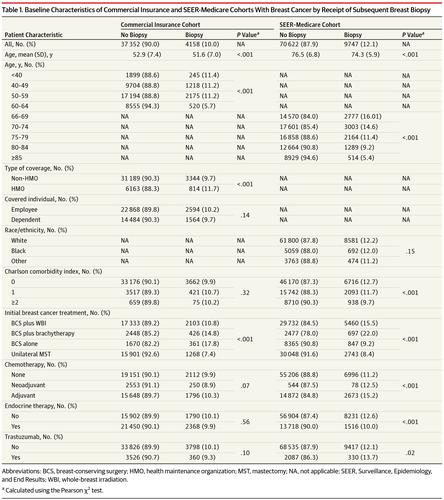JAMA Surgery ( IF 15.7 ) Pub Date : 2018-06-01 , DOI: 10.1001/jamasurg.2017.5572 Raquel F D van la Parra 1 , Kaiping Liao 2 , Benjamin D Smith 3 , Wei T Yang 4 , Jessica W T Leung 4 , Sharon H Giordano 2 , Henry M Kuerer 1

|
Importance No comprehensive data are available regarding the frequency of breast biopsies performed during follow-up of treatment for invasive breast cancer.
Objective To determine how often patients treated for breast cancer require breast biopsies during follow-up.
Design, Setting, and Participants This nationwide population-based cohort study included 41 510 patients 64 years or younger in a commercial insurance database and 80 369 patients 66 years or older in the Surveillance, Epidemiology, and End Results (SEER)–Medicare database. Patients were diagnosed with incident invasive breast cancer (stages I-III) from January 1, 2000, through December 31, 2011. Diagnosis and procedural codes were used to identify biopsy rates during follow-up. Data were analyzed from March 3 through October 3, 2017.
Main Outcomes and Measures Cumulative incidence and adjusted risk of breast biopsy and subsequent breast cancer treatment were calculated using the Kaplan-Meier method and Cox proportional hazards regression. All statistical tests were 2 sided.
Results Among the 121 879 patients in the study population, 5- and 10-year overall incidences of breast biopsy were 14.7% and 23.4%, respectively, in the commercial insurance cohort and 11.8% and 14.9%, respectively, in the SEER-Medicare cohort. The 5-year estimated incidence of breast biopsy was higher among women treated with brachytherapy (24.0% in the commercial insurance and 25.0% in the SEER-Medicare cohorts) than among those treated with whole-breast irradiation (16.7% in the commercial insurance and 15.1% in the SEER-Medicare cohorts) and persisted after multivariate adjustment in the commercial insurance (hazard ratio [HR], 1.53; 95% CI, 1.38-1.70; P < .001) and SEER-Medicare (HR, 1.76; 95% CI, 1.63-1.91; P < .001) cohorts. Adjuvant chemotherapy use (HR, 1.31; 95% CI, 1.25-1.37; P < .001) and patient age (>85 vs 66-69 years; HR, 0.40; 95% CI, 0.36-0.44; P < .001) in the SEER-Medicare cohort and endocrine therapy in the commercial insurance (HR, 0.88; 95% CI, 0.82-0.93; P < .001) and SEER-Medicare (HR, 0.91; 95% CI, 0.85-0.97; P = .002) cohorts were independently associated with biopsy. After unilateral mastectomy, the estimated 5-year contralateral breast biopsy rates were 10.4% and 7.7% in the commercial insurance and SEER-Medicare cohorts, respectively. Of the patients with breast biopsy, 1239 of 4158 patients (29.8%) in the commercial insurance cohort and 2258 of 9747 patients (23.2%) in the SEER-Medicare cohort underwent subsequent cancer treatment.
Conclusions and Relevance These data on the need for breast biopsies during follow-up and subsequent treatments from a large cohort of women with commercial insurance and Medicare can be used in the context of therapy-planning discussions and survivorship expectations for patients with breast cancer.
中文翻译:

乳腺癌治疗后随访期间乳房活检程序的发生率和结果
重要性目前还没有关于浸润性乳腺癌治疗随访期间进行乳腺活检频率的全面数据。
目的确定接受乳腺癌治疗的患者在随访期间需要进行乳腺活检的频率。
设计、设置和参与者这项基于全国人口的队列研究包括商业保险数据库中 41 510 名 64 岁或以下的患者以及监测、流行病学和最终结果 (SEER) – 医疗保险数据库中的 80 369 名 66 岁或以上患者。从2000年1月1日到2011年12月31日,患者被诊断患有偶发性浸润性乳腺癌(I-III期)。诊断和程序代码用于确定随访期间的活检率。数据分析时间为2017年3月3日至10月3日。
主要结果和措施使用Kaplan-Meier方法和Cox比例风险回归计算乳腺活检和随后乳腺癌治疗的累积发生率和调整风险。所有统计检验都是双面的。
结果在研究人群的 121 879 名患者中,商业保险队列中乳腺活检的 5 年和 10 年总体发生率分别为 14.7% 和 23.4%,SEER-Medicare 队列中分别为 11.8% 和 14.9%队列。接受近距离放射治疗的女性(商业保险组为 24.0%,SEER-Medicare 组为 25.0%)的 5 年估计乳腺活检发生率高于接受全乳腺放射治疗的女性(商业保险组为 16.7%,SEER-Medicare 组为 25.0%)。 SEER-Medicare 队列中为 15.1%),并且在商业保险(风险比 [HR],1.53;95% CI,1.38-1.70;P < .001)和 SEER-Medicare(HR,1.76; 95% CI,1.63-1.91;P < .001) 队列。辅助化疗的使用(HR,1.31;95% CI,1.25-1.37;P < .001)和患者年龄(>85 vs 66-69 岁;HR,0.40;95% CI,0.36-0.44;P < 。 001)在 SEER-Medicare 队列中以及商业保险中的内分泌治疗(HR,0.88;95% CI,0.82-0.93;P < .001)和 SEER-Medicare(HR,0.91;95% CI,0.85-0.97) ; P = .002) 队列与活检独立相关。单侧乳房切除术后,商业保险和 SEER-Medicare 队列中估计的 5 年对侧乳房活检率分别为 10.4% 和 7.7%。在接受乳腺活检的患者中,商业保险队列中的 4158 名患者中的 1239 名患者(29.8%)和 SEER-Medicare 队列中的 9747 名患者中的 2258 名患者(23.2%)接受了后续癌症治疗。
结论和相关性这些来自大量拥有商业保险和医疗保险的女性在随访和后续治疗期间需要进行乳腺活检的数据可用于乳腺癌患者的治疗计划讨论和生存预期。











































 京公网安备 11010802027423号
京公网安备 11010802027423号